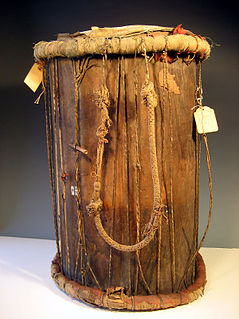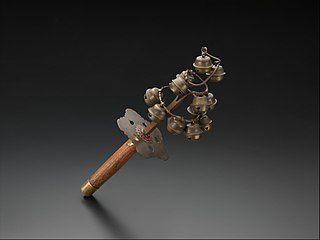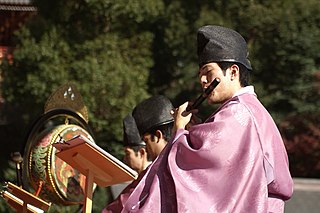 W
WThe balafon is a gourd-resonated xylophone, a type of struck idiophone. It is closely associated with the neighbouring Mandé, Senoufo and Gur peoples of West Africa, particularly the Guinean branch of the Mandinka ethnic group, but is now found across West Africa from Guinea to Mali. Its common name, balafon, is likely a European coinage combining its Mandinka name bala with the word fôn 'to speak' or the Greek root phono.
 W
WThe biwa (琵琶) is a Japanese short necked lute, often used in narrative storytelling. The biwa is the chosen instrument of Benten, goddess of music, eloquence, poetry, and education in Japanese Buddhism. The biwa is a plucked string instrument that was first popular in China and then spread throughout East Asia. It is said to have arrived in Japan from China during the Nara period (710–794), and is even thought to have roots that trace back to Central Asia. It is generally 60 centimetres (24 in) to 106 centimetres (42 in) in length and made from wood. The instrument consists of a water drop shaped body with a handle, and while there are generally four strings, five stringed varieties also exist. In Japan, the biwa is generally plucked with a bachi instead of the fingers, and is often used to play gagaku. In addition, it is used as musical accompaniment when blind monks recite scriptural texts, or when reciting The Tale of the Heike, a war chronicle from the Kamakura period (1185–1333).
 W
WThe bullroarer, rhombus, or turndun, is an ancient ritual musical instrument and a device historically used for communicating over great distances. It dates to the Paleolithic period, being found in Ukraine dating from 18,000 BC. Anthropologist Michael Boyd, a bullroarer expert, documents a number found in Europe, Asia, Africa, the Americas, and Australia.
 W
WThe cithara or kithara was an ancient Greek musical instrument in the yoke lutes family. In modern Greek the word kithara has come to mean "guitar", a word which etymologically stems from kithara.
 W
WConch, or conque, also known as a "seashell horn" or "shell trumpet", is a wind instrument that is made from a conch, the shell of several different kinds of sea snails. Their natural conical bore is used to produce a musical tone. Conch shell trumpets have been played in many Pacific Island countries, as well as South America and Southern Asia.
 W
WGamelan gong kebyar is a style or genre of Balinese gamelan music of Indonesia. Kebyar means "to flare up or burst open", and refers to the explosive changes in tempo and dynamics characteristic of the style. It is the most popular form of gamelan in Bali, and its best known musical export.
 W
WThe hichiriki (篳篥) is a double reed Japanese fue (flute) used as one of two main melodic instruments in Japanese gagaku music. It is one of the "sacred" instruments and is often heard at Shinto weddings in Japan. Its sound is often described as haunting.
 W
WA junjung is the royal war drum of the Serer people in Senegal and the Gambia. It was played on the way to the battlefield, on special state occasions as well as on Serer religious ceremonies.
 W
WKagura suzu (神楽鈴) are a set of twelve bells used in kagura dance. The set consists of three tiers of bells suspended by coiled brass wires from a central handle: two bells on the top tier, four bells on the middle tier, and six bells for the bottom tier. The shape of the bells are thought to have been inspired from the fruits of the ogatama tree.
 W
WKinnor is an ancient Israelite musical instrument in the yoke lutes family, the first one to be mentioned in the Old Testament.
 W
WThe Kobyz or kyl-kobyz is an ancient Turkic string instrument, spread among Kazakhs, Bashkirs, and Tatars under such names as kobyz and kylkobyz. It has two strings made of horsehair. The resonating cavity is usually covered with goat leather.
 W
WThe Malay gamelan is a style of music originated from Indonesia, performed in Malay-populated regions of Indonesia and Malaysia as well.
 W
WThe pahu or paʻu is a traditional musical instrument found in Polynesia: Hawaii, Tahiti, Cook Islands, Samoa, and Tokelau. Carved from a single log and covered on the playing end with a stretched sharkskin, the pahu is played with the palms and fingers of the hand. It is considered a sacred instrument and was generally kept in a temple (heiau), and used to accompany a repertoire of sacred songs called hula pahu/ura paʻu.
 W
WA pan flute is a musical instrument based on the principle of the closed tube, consisting of multiple pipes of gradually increasing length. Multiple varieties of pan flutes have been popular as folk instruments. The pipes are typically made from bamboo, giant cane, or local reeds. Other materials include wood, plastic, metal and ivory.
 W
WThe pedal steel guitar is a console-type of steel guitar with pedals and knee levers that change the pitch of certain strings to enable playing more varied and complex music than any previous steel guitar design. Like all steel guitars, it can play unlimited glissandi and deep vibrati—characteristics it shares with the human voice. Pedal steel is most commonly associated with American country music.
 W
WThe psalmodicon is typically a single-stringed musical instrument, developed in Scandinavia for simplifying music in churches and schools, and providing an alternative to the fiddle for sacred music. The instrument could be plucked or bowed. Beginning in the early 19th century, it was adopted by many rural churches in Scandinavia; later, immigrants brought the instrument to the United States.
 W
WThe ryūteki is a Japanese transverse fue made of bamboo. It is used in gagaku, the Shinto classical music associated with Japan's imperial court. The sound of the ryūteki is said to represent the dragons which ascend the skies between the heavenly lights and the people of the earth. The ryūteki is one of the three flutes used in gagaku, in particular to play songs of Chinese style. The pitch is lower than that of the komabue and higher than that of the kagurabue.
 W
WA shofar is an ancient musical horn typically made of a ram's horn, used for Jewish religious purposes. Like the modern bugle, the shofar lacks pitch-altering devices, with all pitch control done by varying the player's embouchure. The shofar is blown in synagogue services on Rosh Hashanah and at the end of Yom Kippur; it is also blown every weekday morning in the month of Elul running up to Rosh Hashanah. Shofars come in a variety of sizes and shapes, depending on the choice of animal and level of finish.
 W
WA sistrum is a musical instrument of the percussion family, chiefly associated with ancient Egypt. It consists of a handle and a U-shaped metal frame, made of brass or bronze and between 30 and 76 cm in width. When shaken, the small rings or loops of thin metal on its movable crossbars produce a sound that can be from a soft clank to a loud jangling. Its name in the ancient Egyptian language was sekhem (sḫm) and sesheshet (sššt).
 W
WTaiko (太鼓) are a broad range of Japanese percussion instruments. In Japanese, the term refers to any kind of drum, but outside Japan, it is used specifically to refer to any of the various Japanese drums called wadaiko and to the form of ensemble taiko drumming more specifically called kumi-daiko . The process of constructing taiko varies between manufacturers, and the preparation of both the drum body and skin can take several years depending on the method.
 W
WThe term Tanbur can refer to various long-necked string instruments originating in Mesopotamia, Southern or Central Asia. According to the New Grove Dictionary of Music and Musicians, "terminology presents a complicated situation. Nowadays the term tanbur is applied to a variety of distinct and related long-necked lutes used in art and folk traditions. Similar or identical instruments are also known by other terms." These instruments are used in the traditional music of Iran, India, Kurdistan, Armenia, Afghanistan, Pakistan, Turkey, Tajikistan, Kazakhstan, and Uzbekistan.
 W
WThe tanbūra is a bowl lyre of the Middle East. It takes its name from the Persian tanbur via the Arabic tunbur (طنبور), though this term refers to long-necked lutes. The instrument plays an important role in zār rituals. The instrument probably originated in Upper Egypt and the Sudan and is used in the Fann At-Tanbura in the Persian Gulf Arab states.
 W
WTaonga pūoro are the traditional musical instruments of the Māori people of New Zealand.
 W
WThe taphon is a traditional drum of Thailand. It is barrel-shaped with two heads, and is played by the hands and fingers of both hands, much like the more popular congas.
 W
WThe veena comprises a family of chordophone instruments from the Indian subcontinent. Ancient musical instruments evolved into many variations, such as lutes, zithers and arched harps. The many regional designs have different names such as the Rudra veena, the Saraswati veena, the Vichitra veena and others.
 W
WThe yamatogoto (大和琴), also called wagon (和琴) and azumagoto (東琴), is a six- or seven-stringed plucked zither which, unlike the koto and other stringed instruments, is believed to be truly native to Japan, and not imported from mainland Asia. Both names translate literally to "Japanese stringed instrument."